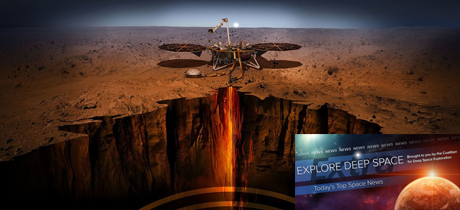In Today’s Deep Space Extra… At Mars, NASA’s InSight lander deploys and shields a mission critical seismometer for first ever measures of the planet’s subsurface activities. Private sector investments in the space sector continue to rise.
Human Space Exploration
Two men spent 340 days in space. Scientists are still figuring out what they’ve learned
Space.com (2/3): In the spring of 2016, NASA astronaut Scott Kelly wrapped up the longest single U.S. spaceflight, a 340 days assignment aboard the International Space Station (ISS) with cosmonaut Mikhail Kornienko. In the aftermath, the human spaceflight community is calling for more long and medium duration missions with similar medical scrutiny to help assess the health challenges that human explorers assigned to deep space missions landing years may face.
SpaceX test-fire of Mars spaceship’s flight engine is milestone for its engine development
Los Angeles Times (2/4): SpaceX offered details of a ground test firing of its Raptor flight version rocket engine late Sunday in McGregor, Texas. The engine, fueled with methane and liquid oxygen, is to power both the Super Heavy and Starship upper stage for future deep space missions.
Space Science
InSight’s seismometer now has a cozy shelter on Mars
NASA’s Jet Propulsion Laboratory (2/4): Since successfully touching down at Mars’ Elysium Planitia on November 26, NASA’s Mars InSight lander has been preparing for its two year mission to reveal the secrets of the Red Planet’s interior. The first step was the use of a robot arm to place a seismometer on the surface, which occurred on December 19. After follow on adjustments, the rover was commanded to place a wind and thermal cover over the seismometer, which took place over the weekend. Next week, InSight is to install a thermal probe, the HP3, to a depth of 16 feet.
Baltimore Sun (2/4): At the Johnson Hopkins University Applied Physics Lab, experts have been gathering to plan a major planetary defense mission planned for 2021-22. NASA’s Double Asteroid Redirection Test will observe as a spacecraft smashes into the smaller asteroid in the pair known as Didymos. The European Space Agency (ESA) is a partner in the exercise.
Pyhs.org (2/4): The Milky Way galaxy’s disk of stars is anything but stable and flat. Instead, it becomes increasingly warped and twisted far away from the Milky Way’s center, according to astronomers from National Astronomical Observatories of Chinese Academy of Sciences (NAOC).
Other News
SpaceX test-fire of Mars spaceship’s flight engine is milestone for its engine development
Los Angeles Times (2/4): SpaceX offered details of a ground test firing of its Raptor flight version rocket engine late Sunday in McGregor, Texas. The engine, fueled with methane and liquid oxygen, is to power both the Super Heavy and Starship upper stage for future deep space missions.
Space startup investments continued to rise in 2018
SpaceNews.com (2/4): The private sector is the source of an impressive increase in the space sector, according to two sources, Seraphim Capital, of London, and Space Angels. Venture capitalists invested $3.25 billion in 2018, up 29 percent over the previous year, according to Seraphim. Space Angels placed the investment at $2.97 billion in 2018, which unlike Seraphim did not include investments in drones. Launch services topped the growth in investments from both analysts.
GEO satellite orders continued to underwhelm in 2018
SpaceNews.com (2/4): In 2018, commercial sector orders for geostationary communications satellites fell from a poor total of seven to five. Some orders that were anticipated failed to materialize. In some cases operators are turning to fewer satellites. Meanwhile the interest in lower altitude and larger numbers of small satellites is growing.
NASA battled cybersecurity threats during government shutdown
Space.com (2/4): While Congress and the White House confront their differences over U.S. immigration policy and the possibility of another partial U.S. government shutdown on February 15, NASA has cautioned that one of its concerns in addition to less pay for workers who have been furloughed or asked to work without pay, is cyber security. NASA is one of the most frequently attacked agencies in the federal government on the cyber security front.

